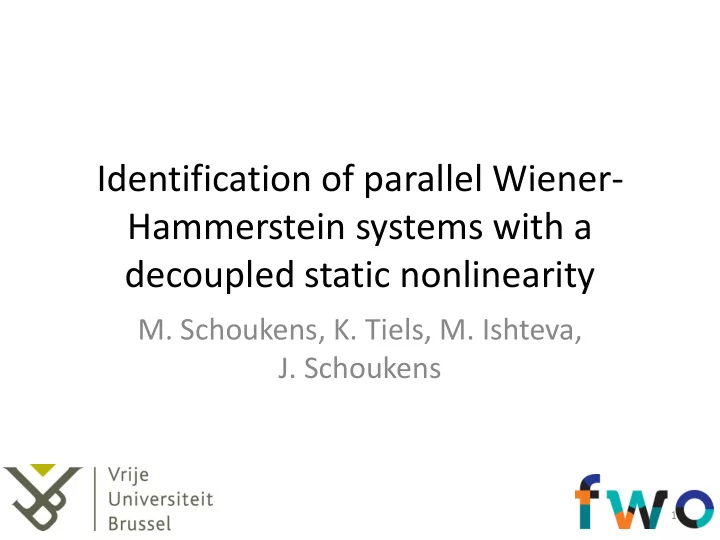

Identification of parallel Wiener- Hammerstein systems with a decoupled static nonlinearity M. Schoukens, K. Tiels, M. Ishteva, J. Schoukens 1
Parallel Wiener-Hammerstein Flexible Simple LTI SNL LTI 2
Identifiability Full rank linear transform 3
Identifiability Full rank linear transform coupled nonlinearity 4
Best Linear Approximation Input signals 5
Best Linear Approximation Input signals Combination of dynamics! 6
Best Linear Approximation Input signals Combination of Fixed poles dynamics! Moving zeros 7
Best Linear Approximation Common denominator – Fixed poles – Moving zeros 8
Decomposing the dynamics numerator coefficients D U V 9
Partition the dynamics 10
Partition the dynamics 11
Partition the dynamics 12
Partition the dynamics 13
Decoupling 14
Decoupling a Static Nonlinearity 15
Decoupling a Static Nonlinearity Homogeneous 2 nd degree Decoupling = matrix diagonalization 16
Decoupling a Static Nonlinearity Homogeneous 3 rd degree 17
Decoupling a Static Nonlinearity Homogeneous 3 rd degree Decoupling = tensor diagonalization 18
Decoupling a Static Nonlinearity Polynomial of degree n – Combine Homogeneous Tensors of different degrees – Add constant input Decoupling = tensor diagonalization 19
Measurement Example Multisine input: System: 5 amplitudes Custom built circuit 12 th order dynamics 20 realizations 2 periods Diode-resistor NL 16384 samples 20
Measurement Example Validation Error (mV) rms(e) Coupled, 3 rd Degree 11.92 Decoupled, 3 rd Degree 31.05 Decoupled, 15 th Degree 0.66 21
Measurement Example 22
Measurement Example 23
Conclusion • Different LTI models parallel Wiener-Hammerstein model • Tensor Diagonalization Decoupling polynomial • Low complexity • High flexibility • Good performance It works! 24
Identification of parallel Wiener- Hammerstein systems with a decoupled static nonlinearity M. Schoukens, K. Tiels, M. Ishteva, J. Schoukens 25
Recommend
More recommend